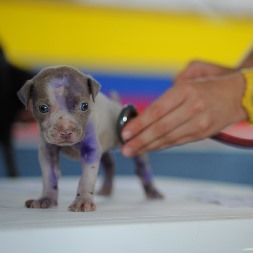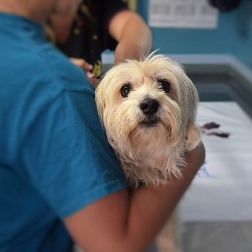How to Choose a Vet Tech School near Cohasset Minnesota
 Achieving your long term aspiration of working with and caring for animals by enrolling in a vet tech college near Cohasset MN may at first seem like a challenging task. After all, you need to find and enroll in a program that will deliver the proper training so that you can succeed as a vet tech. But just how do you go about reviewing and comparing programs so that you can make the best choice? Many potential students launch their due diligence process by searching for colleges that are near their homes. When they have found some area schools, they determine which ones have the lowest tuition and hone in on those. Although cost and location are important concerns when evaluating veterinary technician schools, they are by no means the only critical ones when making your comparisons. Factors such as internship programs and accreditation should be evaluated also. The point is that there are questions you should be asking the vet technician schools you are evaluating before you make an ultimate decision. We have furnished several within this article in order to help get you started, but before we discuss them we’ll talk about the varied responsibilities of vet techs and the training alternatives available.
Achieving your long term aspiration of working with and caring for animals by enrolling in a vet tech college near Cohasset MN may at first seem like a challenging task. After all, you need to find and enroll in a program that will deliver the proper training so that you can succeed as a vet tech. But just how do you go about reviewing and comparing programs so that you can make the best choice? Many potential students launch their due diligence process by searching for colleges that are near their homes. When they have found some area schools, they determine which ones have the lowest tuition and hone in on those. Although cost and location are important concerns when evaluating veterinary technician schools, they are by no means the only critical ones when making your comparisons. Factors such as internship programs and accreditation should be evaluated also. The point is that there are questions you should be asking the vet technician schools you are evaluating before you make an ultimate decision. We have furnished several within this article in order to help get you started, but before we discuss them we’ll talk about the varied responsibilities of vet techs and the training alternatives available.
The Function of a Vet Tech in Cohasset MN
 One of the first decisions that you will need to make is if you want to train as a veterinary technician, assistant or technologist. Part of your preference might be based on the amount of time and money that you have to commit to your education, but the principal factor will most likely be which specialty appeals to you the most. What techs and assistants share in common is that they all work under the immediate direction of a practicing and licensed veterinarian. And while there are many duties that they can perform within the Cohasset MN veterinary practice or hospital, they can’t prescribe medicines, diagnose health issues, or perform surgeries. In those areas they can only provide support to a licensed veterinarian. There are technologists and technicians that work away from the conventional veterinarian practice, such as for animal shelters, zoos or law enforcement. Let’s take a look at the responsibilities and training requirements for each specialization.
One of the first decisions that you will need to make is if you want to train as a veterinary technician, assistant or technologist. Part of your preference might be based on the amount of time and money that you have to commit to your education, but the principal factor will most likely be which specialty appeals to you the most. What techs and assistants share in common is that they all work under the immediate direction of a practicing and licensed veterinarian. And while there are many duties that they can perform within the Cohasset MN veterinary practice or hospital, they can’t prescribe medicines, diagnose health issues, or perform surgeries. In those areas they can only provide support to a licensed veterinarian. There are technologists and technicians that work away from the conventional veterinarian practice, such as for animal shelters, zoos or law enforcement. Let’s take a look at the responsibilities and training requirements for each specialization.
- Vet Assistants in almost all cases will have undergone a formal training program, either as an intern or apprentice in a practice, or by completing a certificate program at a community college or trade school. As the name implies, their job function is to assist the vets and vet techs in the completion of their duties. Generally they are not associated with more complicated undertakings, for example assisting with surgeries. Some of their typical duties may include working at the front desk, preparing and cleaning exam rooms and equipment, or controlling animals during exams.
- Vet Technicians receive more advanced training in contrast to assistants and typically obtain a 2 year Associate Degree, preferably from an American Veterinary Medical Association (AVMA) accredited program. They are in a sense the veterinarian counterparts of medical nurses, since their basic job duty is to assist veterinarians with diagnosing and treating animal patients. Where they vary from veterinary assistants is that they are included in more complex duties, for example assisting with surgical procedures or administering medication. All states presently require veterinary techs pass a credentialing examination for either licensing, registration or certification.
- Vet Technologists are comparable to veterinary technicians and for the most part carry out the same work functions. They are mandated to attain a Bachelor’s Degree in veterinary technology, which typically takes four years. Therefore the main difference between a vet technologist and a technician is the technologist’s more advanced level of education. But with an advanced degree comes more job options, higher salaries and possible management positions. They are additionally mandated to pass a credentialing exam for either certification, registration or licensing.
Veterinary techs and technologists can specialize in areas such as internal medicine, anesthesia or urgent care. Many may earn certification from the American Association for Laboratory Animal Science (AALAS) to work in Cohasset MN labs or research facilities as well.
Online Vet Tech Schools Offered in Cohasset
 An approach that might be a solution for those with a busy lifestyle or who are working full-time while attending vet school is to enroll in an online program. Since the classes are provided over the internet, students can study on their own schedule wherever a computer is available. The syllabus is taught using various venues, including videos, slide shows and live streaming webinars. And since many vet technician and technologist degrees require practical training, that part can usually be completed as an internship or work study program at a local Cohasset MN veterinarian practice or hospital. Distance learning, as it is also called, can in some instances reduce the cost of your education. Tuition and supplementary expenditures, for instance for commuting and study supplies, may be more affordable compared to more traditional classroom programs. Just be sure that the online school that you select is accredited, either by the AVMA or another nationally certified accrediting agency. With the online classes and the clinical training, everything is provided for a complete education. So if you are dedicated enough to learn in this more independent mode, an online vet tech program may be the right option for you.
An approach that might be a solution for those with a busy lifestyle or who are working full-time while attending vet school is to enroll in an online program. Since the classes are provided over the internet, students can study on their own schedule wherever a computer is available. The syllabus is taught using various venues, including videos, slide shows and live streaming webinars. And since many vet technician and technologist degrees require practical training, that part can usually be completed as an internship or work study program at a local Cohasset MN veterinarian practice or hospital. Distance learning, as it is also called, can in some instances reduce the cost of your education. Tuition and supplementary expenditures, for instance for commuting and study supplies, may be more affordable compared to more traditional classroom programs. Just be sure that the online school that you select is accredited, either by the AVMA or another nationally certified accrediting agency. With the online classes and the clinical training, everything is provided for a complete education. So if you are dedicated enough to learn in this more independent mode, an online vet tech program may be the right option for you.
Questions to Ask Cohasset MN Vet Tech Colleges
 By now you probably have decided on which veterinarian degree that you wish to obtain, and if you want to study online or attend a school on campus. Since there are an abundance of veterinary community colleges, vocational and technical schools in the Cohasset MN area as well as across the United States, you should ask some important questions in order to narrow down your list of alternatives. As we pointed out in our opening, many future students start by prioritizing location and tuition expense. But we have already pointed out other essential qualifiers, which include internship programs and accreditation. And of course you need to enroll in a program that offers the specialty and degree that you are interested in. These and other factors are reviewed in the list of questions that you should ask the vet tech programs that you are reviewing.
By now you probably have decided on which veterinarian degree that you wish to obtain, and if you want to study online or attend a school on campus. Since there are an abundance of veterinary community colleges, vocational and technical schools in the Cohasset MN area as well as across the United States, you should ask some important questions in order to narrow down your list of alternatives. As we pointed out in our opening, many future students start by prioritizing location and tuition expense. But we have already pointed out other essential qualifiers, which include internship programs and accreditation. And of course you need to enroll in a program that offers the specialty and degree that you are interested in. These and other factors are reviewed in the list of questions that you should ask the vet tech programs that you are reviewing.
Is the Veterinary College Accredited? It’s imperative that you verify that the veterinary technician college you select is accredited by a regional or national accrediting agency. As previously stated, among the most highly respected is the American Veterinary Medical Association (AVMA). Vocational schools and colleges that are accredited by the AVMA have undergone a demanding review process that confirms you will obtain a superior education. Also, accreditation is important if you are requesting a student loan or financial assistance, since a large number of programs are not obtainable for non-accredited programs. And finally, having a certificate or degree from an accredited college is in many cases a precondition for employment for many Cohasset MN area vet practices and hospitals.
What is the College’s Reputation? The veterinary college or trade school and program you choose must have an exceptional reputation within the vet community. You can initiate your due diligence by asking the schools you are looking at for endorsements from the employers in their job placement network. Other pointers include looking on internet school ranking websites and contacting the school’s accrediting organizations as well. You can ask the Minnesota school licensing department if there have been any complaints or infractions involving your specific schools. As a final recommendation, phone some Cohasset MN vet clinics that you may wish to work for after you get your training. Find out what they think about your school selections. They might even suggest some programs not on your list.
Are Internships Offered? The best means to obtain practical hands on training as a vet tech is to work in a medical setting. Find out if the schools you are reviewing have internship programs established with Cohasset MN veterinarians, vet practices or hospitals. The majority of veterinary medicine programs require clinical training and a large number furnish it through internships. Not only will the experience be valuable regarding the practical training, but an internship can also help build relationships in the local veterinarian community and assist in the search for a position after graduation.
Is Job Placement Offered? Finding a job after graduating from a vet tech program may be challenging without the assistance of a job placement program. First, find out what the graduation rates are for the programs you are considering. A low rate may suggest that the instructors were ineffective at teaching the curriculum or that a number of students were dissatisfied with the program and quit. Next, confirm that the schools have a job assistance program and find out what their placement rates are. A higher placement rate might indicate that the college has an outstanding reputation within the Cohasset MN veterinary community and has a significant network of contacts for student placements. A low rate may indicate that the training is not well regarded by employers or that the job assistance program is ineffective at placing students.
How Large are the Classes? If the classes are larger in size, you probably will receive little or no one-on-one instruction from the teachers. Find out from the Cohasset MN schools you are researching what their classroom teacher to student ratios are. You may also decide to participate in some classes (if practical) to monitor the interaction between instructors and students. Get evaluations from students relating to the quality of instruction. Also, speak with the teachers and determine what their qualifications are as well as their approaches to teaching.
Where is the College Located? Yes, we already covered location, but there are a few more points to consider on the subject. If you are planning to commute to your vet tech classes from your Cohasset MN home, you have to make sure that the driving time fits into your schedule. For instance, driving during the weekend to investigate the route won’t be the same as the commute during rush hour traffic, particularly if the school is located in or close by a larger city. In addition, if you do opt to attend a college in another state or even outside of your County of residence, there may be higher tuition costs particularly for state and community colleges. Of course taking classes online might be an option that will provide you with more flexibility and minimize the necessity for travel.
Is the Class Schedule Flexible? And finally, it’s imperative that you find out if the vet programs you are exploring offer class times that are sufficiently flexible to accommodate your schedule. For instance, a number of students continue working full time and can only go to classes on the weekends or at night near Cohasset MN. Others might only be able to go to classes in the morning or in the afternoon. Make certain that the class times you require are offered before enrolling. In addition, determine if you can make-up classes that you might miss because of work, illness or family responsibilities. You may find that an online program is the best way to fit your veterinary education into your active life.
Enrolling in a Vet Tech School near Cohasset MN?
If you have decided to attend a Veterinary Technician Program in the Cohasset Minnesota area, then you may find the following information about the location of your school campus interesting and informing.
Enbridge Pipeline System
The Enbridge Pipeline System is an oil pipeline system which transports crude oil and dilbit from Canada to the United States. The system exceeds 5,000 kilometres (3,100 mi) in length including multiple paths. More than 3,000 kilometres (1,900 mi) of the system is in the United States while the rest is in Canada and serves the Athabasca oil sands production facilities. Main parts of the system are 2,306-kilometre-long (1,433 mi) Canadian Mainline[1] and 3,057-kilometre-long (1,900 mi) Lakehead System (U.S. Mainline).[2] On average, it delivers 1.4 million barrels per day (220×10^3 m3/d) of crude oil and other products to the major oil refineries in the American Midwest and the Canadian province of Ontario. The Canadian portion is owned by Enbridge, while the U.S. portion is partly owned by that company through Enbridge Energy Partners, LP, formerly known as Lakehead Pipe Line Partners and Lakehead Pipe Line Company.
The first portion of the pipeline was built over the course of 150 days in 1950 by a 1,500-man labor force. It crossed approximately 1,600 kilometres (990 mi) from Redwater, Alberta, through Saskatchewan, Manitoba, North Dakota, and Minnesota, to the Great Lakes seaport of Superior, Wisconsin. At the same time, four oil tankers were constructed to carry the crude from Superior to oil refineries in Sarnia, Ontario. Oil first entered the pipe on August 25, 1950, and the first tanker, Imperial LeDuc, was launched on November 4. Other tankers that followed were, Imperial Redwater, Imperial Woodbend, and B.A. Peerless.[3]
Because the lakes froze in the winter, preventing tanker traffic, the decision was soon made to expand the pipeline all the way to Sarnia. In May 1953, contracts were awarded and construction began. At 2,840 kilometres (1,760 mi), it became the world's longest pipeline. A major upgrade was undertaken in the 1990s to replace old pipe and expand the system.
Pick the Right Veterinary Technician School near Cohasset MN
 Picking the appropriate veterinary technician school is a critical first step to beginning a rewarding career providing care and treatment for pets and livestock. Potential students thinking about veterinary technician colleges need to make their determination based on a number of key issues. Veterinary technicians and technologists work in vet clinics, animal hospitals and animal shelters. They typically take on administrative tasks and assist the veterinarian with the animals when needed. As we have discussed, it’s very important that you enroll in a veterinary medicine program that is both accredited and has an excellent reputation within the profession. This goes for vet tech online colleges as well. By asking the questions included in our checklist for reviewing schools, you will be able to reduce your alternatives so that you can make your final decision. And by picking the ideal college, you can accomplish your goal of becoming a veterinary technician in Cohasset MN.
Picking the appropriate veterinary technician school is a critical first step to beginning a rewarding career providing care and treatment for pets and livestock. Potential students thinking about veterinary technician colleges need to make their determination based on a number of key issues. Veterinary technicians and technologists work in vet clinics, animal hospitals and animal shelters. They typically take on administrative tasks and assist the veterinarian with the animals when needed. As we have discussed, it’s very important that you enroll in a veterinary medicine program that is both accredited and has an excellent reputation within the profession. This goes for vet tech online colleges as well. By asking the questions included in our checklist for reviewing schools, you will be able to reduce your alternatives so that you can make your final decision. And by picking the ideal college, you can accomplish your goal of becoming a veterinary technician in Cohasset MN.
Other Doggone Good Cities in Minnesota




